I have reviewed several microphones, preamps and other devices from IK Multimedia (and many other brands). The iRig Mic Studio is the first microphone from this innovative Italian company to include the word studio in its official model name. The iRig Mic Studio fortunately supports 48 kHz for video compliancy, and comes ready from the factory to be omniplatform, meaning that this digital microphone is compatible and includes the necessary cables to connect with many Android, iPad/iPhone/iPod Touch, Mac, and Windows computers while bypassing those devices’ internal —and inferior— preamp/A-to-D converter. Ahead you’ll find details, clarifications about its headphone output, and simultaneous test recordings with other mics, including the Audio Technica BP40 and AT2005USB.
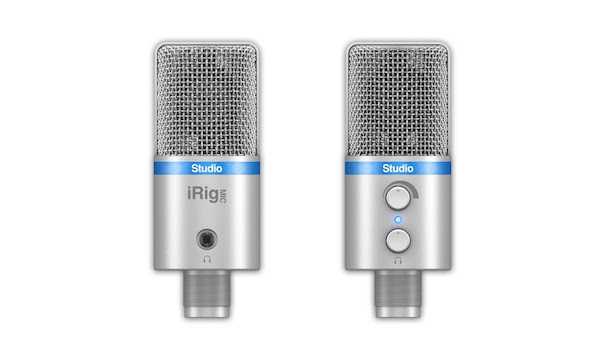
I have reviewed several microphones, preamps and other devices from IK Multimedia (and many other brands). The iRig Mic Studio is the first microphone from this innovative Italian company to include the word studio in its official model name. The iRig Mic Studio fortunately supports 48 kHz for video compliancy, and comes ready from the factory to be omniplatform, meaning that this digital microphone is compatible and includes the necessary cables to connect with many Android, iPad/iPhone/iPod Touch, Mac, and Windows computers while bypassing those devices’ internal —and inferior— preamp/A-to-D converter. Ahead you’ll find details, clarifications about its headphone output, and simultaneous test recordings with other mics, including the Audio Technica BP40 and AT2005USB.
iRig Mic Studio specifications and comments
Microphone type: condenser, back electret
Capsule size: 1-inch, which is larger than most other mics I have reviewed to date, with the notable exception of the Audio Technica BP40, reviewed here, with comparative recordings ahead in this article. By comparison, the BP40’s capsule measures 37 mm (approximately 1.46 inches).
Polar pattern: cardioid
Interface type: USB digital microphone, built-in low-noise high-definition preamp
Frequency response: 20Hz – 20kHz, –3dB
Gain range: 40dB
Maximum sound pressure: 133dB
Sensitivity: –42±3dB at 1 kHz, 0dB=1V/Pa
Equivalent noise level, A-weighted: 11dB-A
Resolution & sample Rate: 24-bit (details ahead) up to 48kHz recording for audio for video compliancy. It’s also capable of 44.1 kHz for a direct match to the waining Audio Disc Digital Audio, aka Compact Disc or CD.
Inboard connector type: standard micro-USB
Headphone output: 3.5mm/1/8” jack (details ahead)
Power: powered by connected device
Controls: Built-in mic gain and headphone volume controls
Visible confidence: Built-in multicolor LED for status and audio level indication
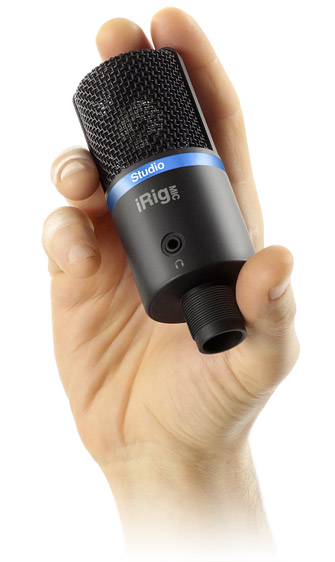
Size: 45mm x 117mm (1.77 inches x 4.61 inches) which is vertically shorter than most modern smartphones
Weight: 218 grams (7.69 ounces)
iRig Mic Studio iOS compatibility
![]()
The iRig Mic Studio is compatible with iPhone 6 Plus, iPhone 6, iPhone 5s, iPhone 5c, iPhone 5, iPhone 4S*, iPhone 4*, iPod touch (4th* and 5th generation), iPad Air 2, iPad mini 3, iPad Air, iPad mini 2, iPad 4th generation, iPad mini, iPad 3rd generation*, iPad 2* and iPad*. iOS 5.1 or later is required.
*The models that have the asterisk have the older 30-pin connector and require the 30-pin cable (sold separately).
iRig Mic Studio Android compatibility
![]()
- Compatible with Android devices with USB (OTG) connector running Android apps that use USB (OTG) audio input and Android 5 or later.
- The iRig Mic Studio is also compatible with Android devices that support Samsung Professional Audio technology, like the Samsung Galaxy S6, Galaxy S6 Edge, Galaxy Note 4 and Galaxy Note Edge. Samsung Galaxy S5 and Galaxy Note 3 require Android 5.
iRig Mic Studio Mac compatibility
The iRig Mic Studio is compatible with Mac OS X 10.6 or later, and requires a free USB port.
iRig Mic Studio Windows compatibility
The iRig Mic Studio is compatible with Windows XP/Vista/7/8 via the ASIO4ALL driver on Windows. See IK Multimedia’s FAQ here for further details. (Nothing is yet published about iRig Mic Studio with Windows 10.)
iRig Mic Studio package contents
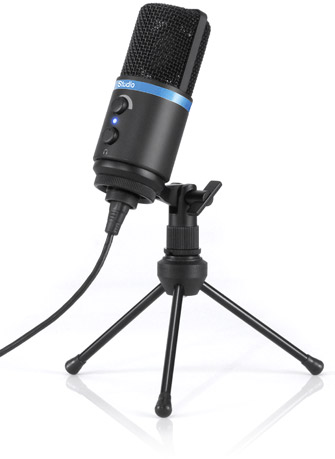
- iRig Mic Studio digital microphone
- Lightning connection cable (for recent iOS devices, iPad/iPhone/iPod Touch)
- OTG connection cable (for many Android models)
- USB connection cable (for Mac or Windows computers)
- Protective storage bag
- Mic clamp
- Tabletop tripod (Like the one that comes with the AT2005USB)
All of the cables mentioned above measure 1.5 meter (59 inches).
All about the iRig Mic Studio’s omniplatform connectivity
As stated in the introductory paragraph of this article, the iRig Mic Studio comes ready from the factory to be omniplatform, meaning that this digital microphone comes with the necessary cables to connect with many Android, iPad/iPhone/iPod Touch, Mac, and Windows computers while bypassing those devices’ internal —and inferior— preamp/A-to-D converter. An optional cable must only be purchased to connect the iRig Mic Studio to an older iOS device that uses the older 30-pin port.
Advantages of recording 24-bit even if you never distribute that way
The iRig Mic Studio fortunately has a 24-bit A-to-D (analog-to-digital) converter, which allows you to record at 24-bit resolution if your recording software allows for it. As I explained in detail in this article Understanding 24-bit vs 16-bit audio production & distribution from March 2015. As I explained in detail in that article, there are definite advantages to making recordings and mastering in 24-bit, even if you’ll never deliver the final product in 24-bit, especially when you may be surprised that an interviewee unexpectedly and momentarily lowers the volume of her/his voice, and you need to boost it during editing with minimal loss.
How do I select the desired sampling frequency between 44.1 kHz and 48 kHz?
It is actually much simpler to select the desired sampling frequency from a single digital microphone (or A-to-D converter) on iOS (iPad/iPhone/iPod Touch) or on an Android device than on a Mac. On iOS or compatible Android devices, you have to select it in a single place, in the recording app, if available (as it fortunately is the case with iOS with RØDE Rec, FiLMiC Pro, and ShurePlus MOTIV, and on compatible Android devices with USB Audio Recorder PRO). On a Mac, you must select the desired frequency sampling rate in two different places with most software I have used: first in the Audio Midi Setup (which is currently located in the Utility folder in modern Macs), and then in the recording app itself. If it is set differently in each place, you can get undesired results or force an undesired re-sampling, so remember to switch it in both places and in that order, and always check to see whether it has stuck (been remembered). I really don’t know where it is switched in the Windows operating system. I set the A-to-D converter in all devices used in this test to 48 kHz to match the standard for digital audio for video.
iRig Mic Studio multitrack capabilities
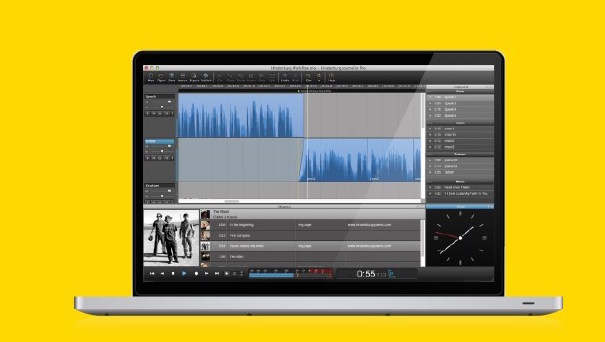
Using special software and configurations, it is now possible to connect multiple digital microphones like the iRig Mic Studio directly to a Mac/Windows computer (although with some “gotchas”), which is a topic to be covered in an upcoming article about multitrack recording. In fact, I used the new multitrack feature in Hindenburg Journalist Pro (reviewed in Meet the Hindenburg family of audio production/editing tools and Why Hindenburg Journalist PRO is the best Skype audio production tool I’ve ever used to make the test recordings that are ahead in this article.
Where no digital-exclusive mic can go
Digital-exclusive microphones like the iRig Mic Studio cannot be connected to the analog microphone XLR input of any professional audio mixer, professional video camcorder, professional audio recorder or professional video recorder I have ever seen, since digital-exclusive microphones lack an analog output. Digital-exclusive microphones like the iRig Mic Studio are designed to be connected directly to your computer, smartphone, tablet or phablet, not to a professional camera, audio recorder or video recorder. Of course, you may use a digital-only microphone like the iRig Mic Studio to your computer, smartphone, or phablet to create a dual-system recording for later synchronization with video shot independently.
About the iRig Mic Studio’s knobs (potentiometers) and LED
The iRig Mic Studio contains knobs (potentiometers) and a single, multicolor LED. One of the knobs is for the gain of the microphone, similar to the one on three other IK Multimedia products I have reviewed: two handheld digital-only microphone models, the iRig Mic HD for iOS and computers (reviewed here), the iRig Mig HD-A for Android and computers (reviewed here), and the iRig Pro preamp/A-to-D converter (reviewed here). Together with the multicolor LED, you can use the gain knob to me sure that you are modulating at a good level yet not clipping: You speak at your highest level, increase gain until the LED blinks red, and then back off a bit.
The other knob controls the volume level sent to the headphone output. We’ll cover more about the use of this headphone output ahead in this article.
iRig Mic Studio SCM rating and clarification about its built-in headphone jack
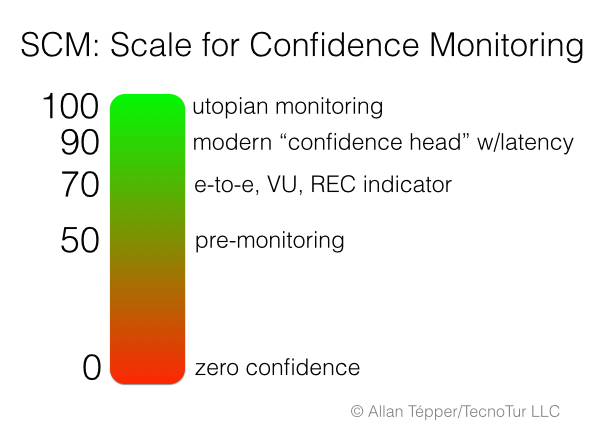
You may recall the SCM scale from my recent article called Establishing SCM: a standard Scale for Confidence Monitoring, illustrated above.
By itself, the iRig Mic Studio earns a 50 rating on the SCM scale, thanks to its multicolor LED, not thanks to its headphone jack. Unlike the headphone jack built-into the AT2005USB, the RØDE NT-USB digital mic (reviewed here), and the Shure X2U preamp/A-to-D converter (which all have a latency-free output directly from the built-in preamp), the headphone jack on the iRig Mic Studio is actually a return from the connected device’s software, if available. As a result, in order to hear yourself live as you record or broadcast, that capability must exist in the recording or broadcasting software, and in all systems I have ever tried that have it, there will be some latency when done that way. When combined with recording software that has a display of one —or more than one— VU meter and recording indicator and/or timecode progression, the systematic SCM rating can rise to 75. For full information, see the SCM article. Although the built-in headphone output is welcome compared to having none, as in the case with all Apogee mics I have seen so far, and with the digital mics from IK Multimedia I have reviewed previously, I was really expecting the iRig Mic Studio to have a latency-free output like the AT2005USB, RØDE NT-USB, and Shure X2U all offer. Of course, there are unique advantages to the iRig Mic Studio that —depending upon your priorities— might be more important than the latency-free monitoring output. Of all of the devices mentioned in this article, the iRig Mic Studio is the only one that is officially compatible with Android, and is also the only one that features 24-bit resolution in its A-to-D converter. The others mentioned in this paragraph have a 16-bit resolution in their inboard A-to-D converter.
Other uses of the iRig Mic Studio headphone output
Like the headphone output on some other digital-exclusive or hybrid microphones, the one on the iRig Mic Studio goes beyond confidence to hear yourself (albeit with latency) while you record or broadcast live: It also allows you to hear the other person/people if used with Skype or Hangouts (at least with a Mac) or to play back already recorded material from your computer, whether it be to check what you just recorded, or to narrate or dub an existing track, i.e. in a multitrack DAW like Adobe Audition/Apple Logic/Hindenburg Journalist Pro/Pro Tools or with a video editing program like Final Cut Pro X, as covered in Mark Spencer’s article/video The Improved Voiceover Tool in FCP X.
Simultaneous comparative audio recordings
All of the below recordings were done simultaneously at the audio-for-video standard of 48 kHz. The AT2005USB and iRig Mic Studio used their inboard A-to-D converter at their respective maximum resolution. The BP40 was recorded using the iRig Pro external preamp/A-toD converter, also at its maximum resolution (24-bit). All recordings were leveled to –16 LUFS segment-by-segment upon export (See my Meet the Hindenburg family of audio production/editing tools article for information about LUFS loudness) as uncompressed WAV mono 48 kHz and uploaded to SoundCloud. SoundCloud automatically created a corresponding MP3 for streaming. You may also download the uncompressed WAV files of each.
Sensitivity to the air conditioning sound
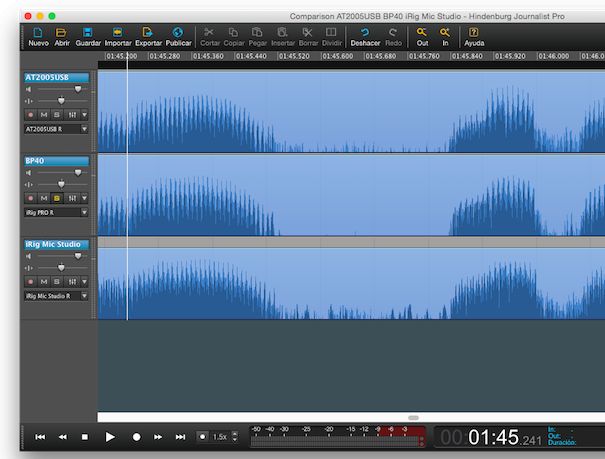
Click here to see this image in full size
As you will see in the above multitrack screenshot from Hindenburg Journalist Pro (after leveling), the BP40 is the least sensitive to air conditioning (even though its internal switch was set to flat at all times), since it virtually flatlined as I paused my speech, while with the AT2005USB the air conditioning sound is visible somewhat, and the iRig Mic Studio is the most sensitive to it. I remind you that the BP40 (even when set to flat using its toggle switch) has a published frequency response of 50–16,000 Hz and a narrower hypercardioid pattern; the AT2005USB has a published frequency response of 50–15,000 Hz and a cardioid pattern; while the iRig Studio Mic has a much wider published frequency response of 20–20,000 Hz and a cardioid pattern, and was designed not only for voice recording,
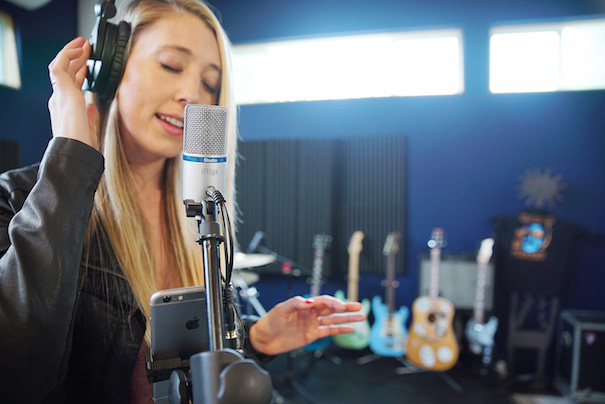
but also for musical instrument recording.
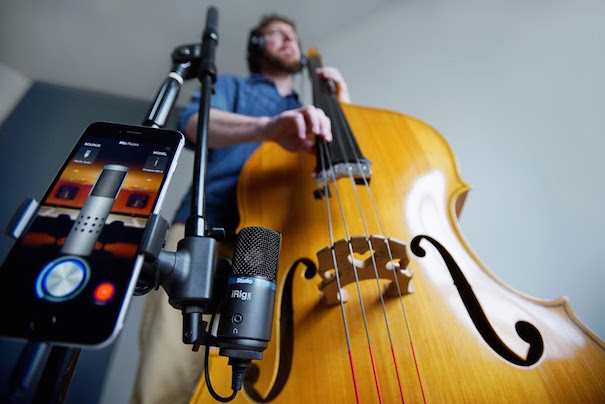
Given all of these factors and that air conditioning sound is low frequency, this should not be a great surprise. Of course, if you want to record voice-only with the iRig Studio Mic in an environment with air conditioning or other undesired low frequency background sound, you could apply a low-cut (aka high pass) filter in post-production.
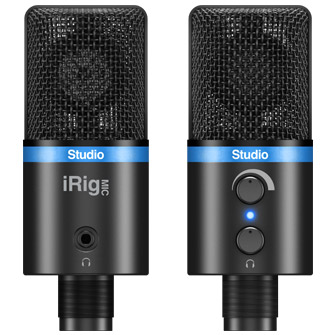
The iRig Mic Studio is also available in black at the same price
Why I did not review any of IK Multimedia’s recording apps for Android or iOS
The mystery continues: Although all digital hardware products I have ever tested from IK Multimedia thankfully do support 48 kHz, for some strange reason, IK Multimedia’s recording app division continues to ignore this essential sampling rate for video producers, and even for audio producers who have adopted the 48 kHz standard. Fortunately, there are third-party Android and iOS applications that support 48 kHz recording and are compatible with IK Multimedia hardware. For iOS we have RØDE Rec, FiLMiC Pro, and ShurePlus MOTIV, and on compatible Android devices we have USB Audio Recorder PRO).
Observations and conclusions
Many factors affect a decision about which microphone to purchase, including budget, connectivity, usage and sound quality. The last one is obviously subject to personal taste. As stated in previous articles, each microphone has its own “flavor”. In this case of the comparison I made for this article, the three flavors are notably different. Fortunately, none is bad; and all are good. In this article, I have pointed out unique benefits as well as unique weaknesses in the iRig Mic Studio and in competing microphones from the same and other manufacturers, all of which I hope will help you to make your best choice.
Related articles
- Don’t use the term podcast in vain
- Embedding audio on the web, Facebook and sometimes even YouTube
- Review: Audio-Technica BP40 high-end dynamic studio microphone
- Review: Sennheiser PC–8 digital mic/headset with 48 kHz sampling
- Audio tests with Átomos Shogun and Sony A7s
- Establishing SCM: a standard Scale for Confidence Monitoring
- Why Hindenburg Journalist PRO is the best Skype audio production tool I’ve ever used
- How to do your audio setup for a live TV studio
- Meet the Hindenburg family of audio production/editing tools
- Initial review: ShurePlus MOTIV Mobile Recording app for iOS
- Review: two stereo mics for iOS (iPhone/iPad/iPod)
- Review: USB Audio Recorder PRO app for Android
- Review: iRig Mic HD-A for Android from IK Multimedia
- Initial review: iRig Mic HD from IK Multimedia
- Understanding 24-bit vs 16-bit audio production & distribution
Upcoming articles, reviews, and books
Stand by for upcoming articles, reviews, and books. Sign up to my free mailing list by clicking here.
Si deseas suscribirte a mi lista en castellano, visita aquí. Si prefieres, puedes suscribirte a ambas listas (castellano e inglés).
Books, consulting, articles, seminars & audio programs
Contact Allan Tépper for consulting, or find a full listing of his books, articles and upcoming seminars and webinars at AllanTepper.com. Listen to his CapicúaFM program at CapicúaFM.com in iTunes or Stitcher.
My latest book (paperback + ebook)

My most recent book is available in two languages, and in paperback as well as an ebook. The ebook format is Kindle, but even if you don’t have a Kindle device, you can read Kindle books on many other devices using a free Kindle app. That includes iPad, Android tablets, Mac computers, and Windows computers. Although generally speaking, Kindle books are readable on smartphones like Androids and iPhones, I don’t recommend it for this particular book since it contains both color photos and color comparison charts. The ebook is also DRM-free.
In English, it’s The Castilian Conspiracy. Click here and you will be automatically sent to the closest Amazon book page to you based upon your IP address. Or request ISBN–10: 1456310232 or ISBN–13: 978–1456310233 in your favorite local bookstore.
En castellano, se llama La conspiración del castellano. Haz clic aquí para llegar al instante a la página del libro correspondiente a tu zona y moneda en Amazon, según tu dirección IP. De lo contrario, solicítalo en tu librería preferida con los ISBN–10: 1492783390 ó el ISBN–13: 978–1492783398.
FTC disclosure
No manufacturer is specifically paying Allan Tépper or TecnoTur LLC to write this article or the mentioned books. Some of the other manufacturers listed above have contracted Tépper and/or TecnoTur LLC to carry out consulting and/or translations/localizations/transcreations. Many of the manufacturers listed above have sent Allan Tépper review units. So far, none of the manufacturers listed above is/are sponsors of the TecnoTur programs, although they are welcome to do so, and some are, may be (or may have been) sponsors of ProVideo Coalition magazine. Some links to third parties listed in this article and/or on this web page may indirectly benefit TecnoTur LLC via affiliate programs.
Copyright and use of this article
The articles contained in the TecnoTur channel in ProVideo Coalition magazine are copyright Allan Tépper/TecnoTur LLC, except where otherwise attributed. Unauthorized use is prohibited without prior approval, except for short quotes which link back to this page, which are encouraged!

Filmtools
Filmmakers go-to destination for pre-production, production & post production equipment!
Shop Now














